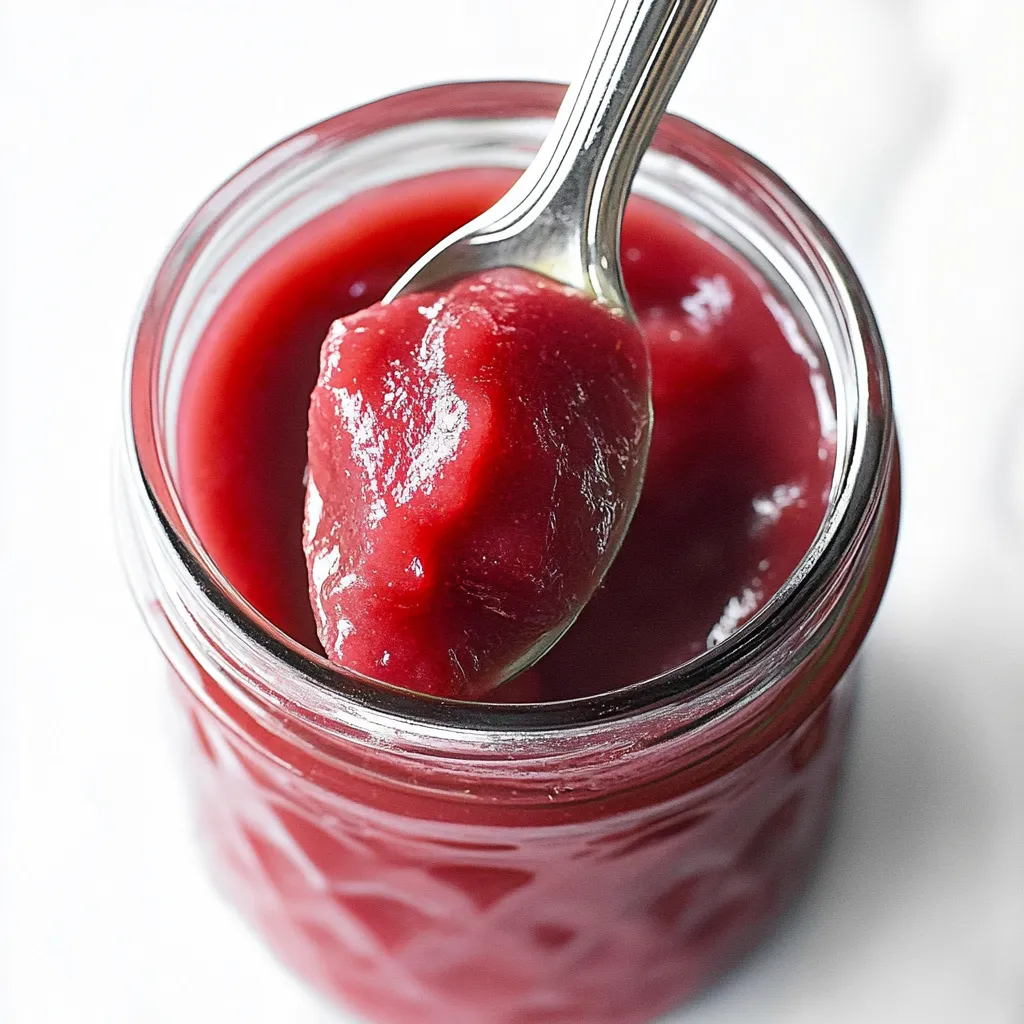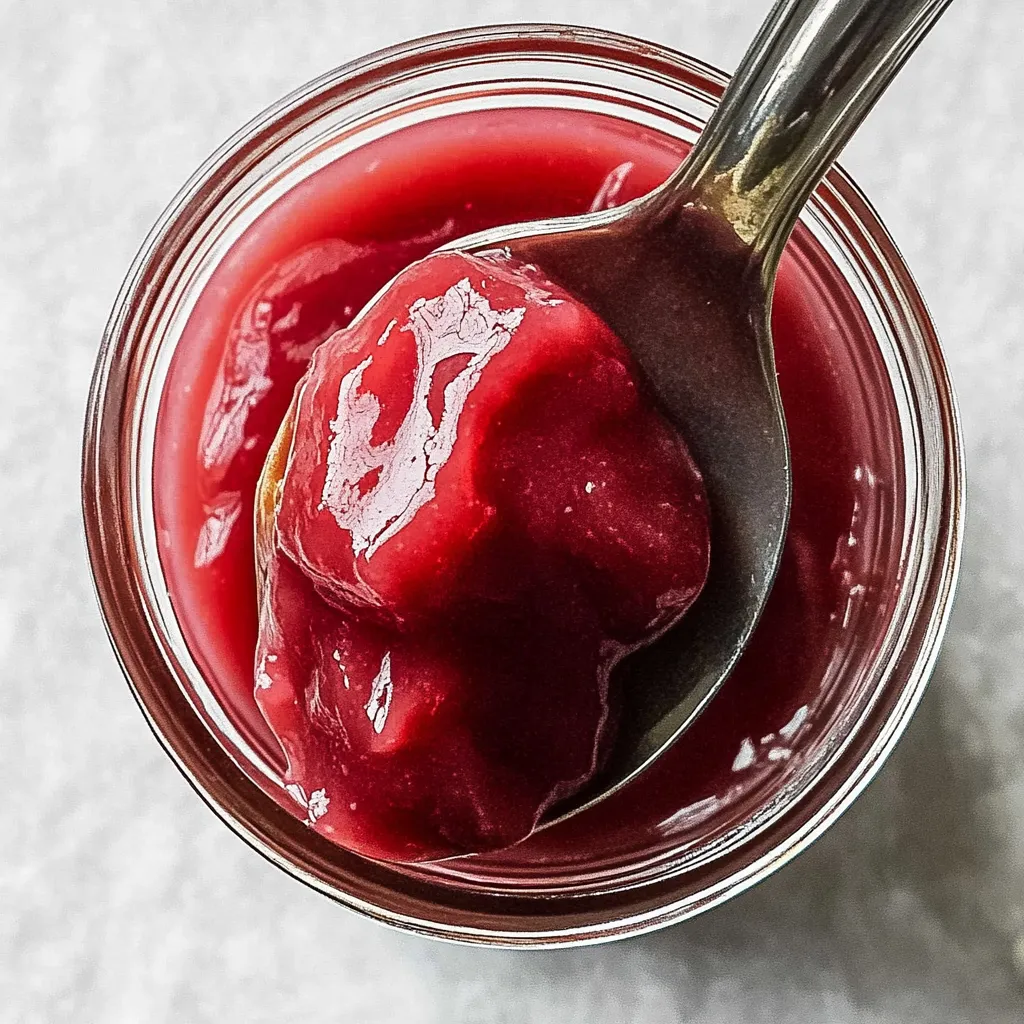 Pin it
Pin it
This silky, jewel-toned rhubarb butter captures all the bright, tangy essence of fresh rhubarb in a luxurious spread that's infinitely more special than anything you could buy in a store. The simple process of cooking down rhubarb with just sugar and lemon juice creates an intensely flavored, smooth butter that transforms ordinary toast into something truly gourmet while showcasing rhubarb's unique tartness in the most concentrated, delicious form possible. Unlike complicated preserves that require pectin, precise temperatures, and canning expertise, this foolproof method delivers professional results using basic cooking techniques that any home cook can master.
I discovered this recipe when I had an abundance of beautiful red rhubarb and wanted to preserve its incredible flavor in a form that would last beyond the short growing season. The first time I made it, I was amazed at how something so simple could taste so intensely delicious - it was like capturing the essence of spring in a jar, and now I make it every year as soon as the first rhubarb appears.
Essential Ingredients and Selection Tips
- Fresh rhubarb: Choose the reddest stalks you can find for the most beautiful color; firm, crisp stalks without browning or limpness work best
- Granulated sugar: The amount balances rhubarb's natural tartness while helping preserve the butter; don't reduce the quantity or the final product won't set properly
- Fresh lemon juice: Always squeeze your own for the brightest flavor; bottled lemon juice lacks the fresh acidity needed to balance the sweetness and enhance rhubarb's natural tang
The secret to gorgeous color is selecting the reddest rhubarb stalks available, as the green portions won't contribute to that beautiful jewel-toned appearance that makes this butter so visually appealing.
Detailed Step-by-Step Instructions
- Step 1: Prepare the rhubarb:
- Wash the rhubarb stalks thoroughly and trim off any leaves (which are toxic) and the bottom ends. Cut the stalks into 1-inch pieces - this size will cook down efficiently while ensuring even cooking throughout the process.
- Step 2: Begin the cooking process:
- Place the chopped rhubarb in a heavy-bottomed, non-reactive pot (stainless steel or enameled cast iron work best). Add the sugar and lemon juice, stirring to combine everything evenly.
- Step 3: Cook until soft (Stage 1):
- Bring the mixture to a gentle boil over medium heat, then reduce to medium-low and simmer for 15-20 minutes, stirring occasionally, until the rhubarb is completely soft and breaking apart. The mixture will be quite liquid at this stage - this is normal.
- Step 4: Prepare for blending:
- Remove the pot from heat and let the mixture cool for about 5 minutes to reduce the risk of splattering during blending. Hot liquid can be dangerous in blenders, so this cooling period is important for safety.
- Step 5: Blend until smooth (Stage 2):
- Transfer the cooked rhubarb to a blender, filling it no more than halfway full to prevent overflow. Secure the lid tightly, cover with a kitchen towel, and blend until completely smooth and silky - about 1-2 minutes depending on your blender's power.
- Step 6: Return to cooking (Stage 3):
- Pour the smooth puree back into the pot and return to medium-low heat. Cook, stirring frequently with a long-handled spoon, for 20-30 minutes until the mixture thickens significantly and becomes glossy.
- Step 7: Test for doneness:
- The butter is ready when you can draw a spoon across the bottom of the pot and the mixture doesn't immediately flow back to fill the space. It should be thick enough to coat the spoon heavily and have a deep, rich color.
- Step 8: Final consistency check:
- Remember that the butter will thicken further as it cools, so don't overcook it to the point where it becomes stiff in the pot. It should be spreadable when warm but will firm up nicely when chilled.
- Step 9: Cool and store:
- Let the rhubarb butter cool completely before transferring to clean jars. It will keep in the refrigerator for 2-3 weeks or can be frozen for up to a year in appropriate containers.
 Pin it
Pin it
The most critical technique is maintaining gentle heat during the final reduction stage to prevent scorching while achieving the proper thick, spreadable consistency.
This rhubarb butter recipe has become my favorite way to preserve the fleeting spring rhubarb season because it captures such pure, concentrated flavor in a form that lasts for months. My neighbors always request jars when I'm making it because they say it tastes like the essence of spring itself, which I consider the ultimate compliment.
Understanding Fruit Butter Science and Concentration
Fruit butters work through the principle of moisture reduction and flavor concentration. As water evaporates during the long cooking process, the fruit's natural sugars, acids, and pectin become more concentrated, creating the thick, spreadable consistency and intense flavor that defines good fruit butter. Rhubarb's high water content means significant cooking time is needed to achieve proper thickness, while its natural acidity helps preserve the finished product and maintain bright flavor even after concentration.
Heat Management and Texture Development
Successful fruit butter requires understanding how to manage heat to achieve reduction without scorching. The initial cooking breaks down cell walls and begins moisture evaporation, while the final stage requires careful attention to prevent burning as the mixture thickens. The stirring technique becomes crucial as the butter thickens - frequent scraping prevents sticking while ensuring even heat distribution. The glossy appearance that develops indicates proper concentration and caramelization of natural sugars.
Blending Safety and Technique
Blending hot fruit mixtures requires specific safety precautions to prevent dangerous splattering. The cooling period before blending reduces the risk of steam buildup that can cause lids to pop off violently. Filling the blender only halfway provides space for expansion, while the kitchen towel adds an extra safety barrier. The goal is achieving complete smoothness that creates the silky texture that distinguishes fruit butter from chunky preserves.
Color Development and Visual Appeal
The beautiful color in rhubarb butter comes from anthocyanins concentrated in red rhubarb stalks. These compounds intensify during cooking, creating deeper, richer color than fresh rhubarb. Green stalks won't contribute to the desired jewel tone, making variety selection important for visual appeal. The final glossy appearance results from proper reduction and sugar caramelization that creates both appealing shine and complex flavor development.
Storage Science and Preservation
Small-batch fruit butters like this rely on sugar concentration and acidity for preservation rather than formal canning processes. The high sugar content creates an environment that inhibits bacterial growth, while the natural and added acids provide additional preservation. Proper storage in clean containers and refrigeration extends shelf life safely. Freezing works well because the smooth texture isn't damaged by ice crystal formation like whole fruit preserves might be.
This rhubarb butter has taught me that some of the most rewarding preserving projects are the simplest ones that let the fruit's natural character shine through without complicated techniques or additives. Every time I make it, I'm reminded that good cooking often comes down to patience and understanding how basic processes like reduction and concentration can transform humble ingredients into something truly special.
Frequently Asked Questions
- → How long does rhubarb butter last in the fridge?
- Rhubarb butter stays fresh in the refrigerator for up to 2 weeks when stored in a clean glass jar with a tight lid.
- → Can I freeze rhubarb butter for later?
- Yes, rhubarb butter freezes well for up to 6 months. Thaw in the fridge overnight before using.
- → What can I use rhubarb butter for?
- Spread it on toast, muffins, biscuits, pancakes, or use it as a filling for pastries. Some people eat it straight from the jar!
- → Do I need to remove rhubarb leaves before cooking?
- Yes, always trim and discard rhubarb leaves as they contain toxic compounds. Only use the pink and green stalks for cooking.
- → How do I know when the rhubarb butter is thick enough?
- The butter is ready when you can drag a spoon across the pan bottom and the mixture doesn't immediately flow back to fill the space.
- → Can I add spices to my rhubarb butter?
- Absolutely! Try adding vanilla, cinnamon, or cardamom after pureeing. Start with 1/4 teaspoon and adjust to taste.
